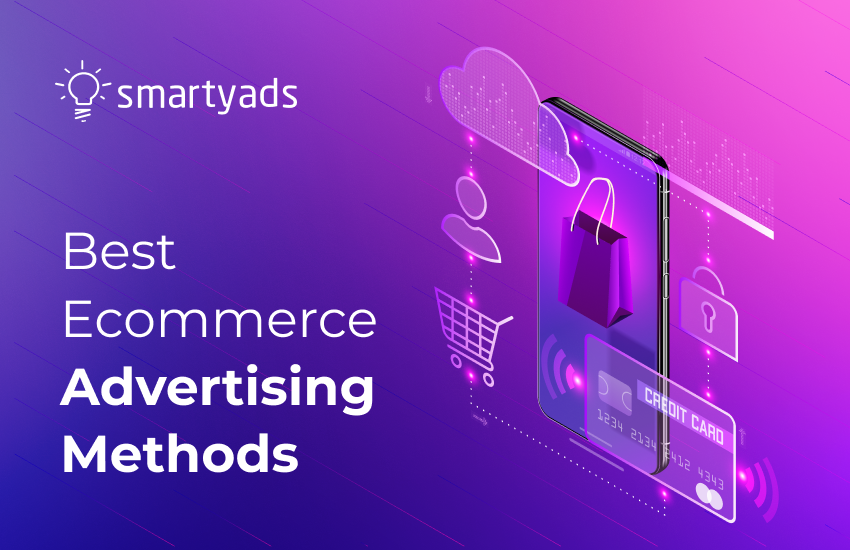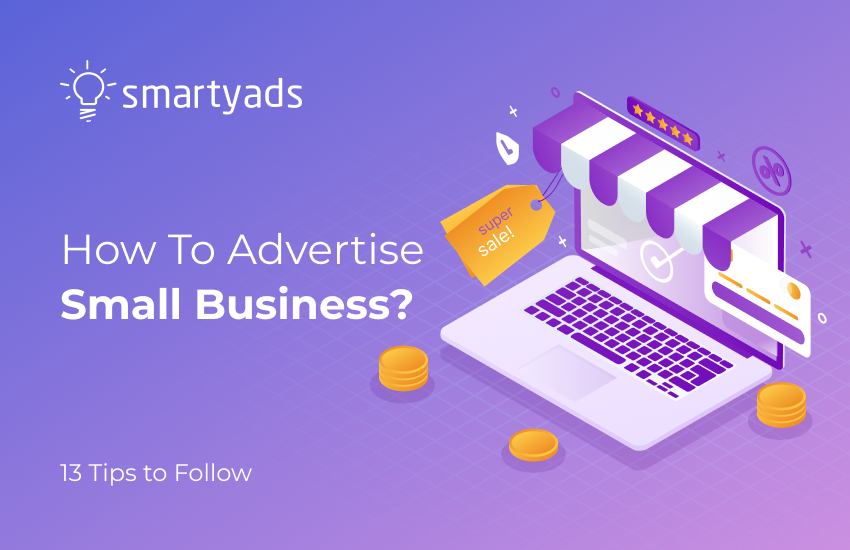The ecommerce advertising market is growing exponentially. Sounds impressive, but if we look at the more short-termed predictions, it becomes clear that this future is not distant.
By 2023, global ecommerce sales will reach $6.5 trillion, and with the impact of a COVID-19 traffic surge, this transformation will only accelerate.
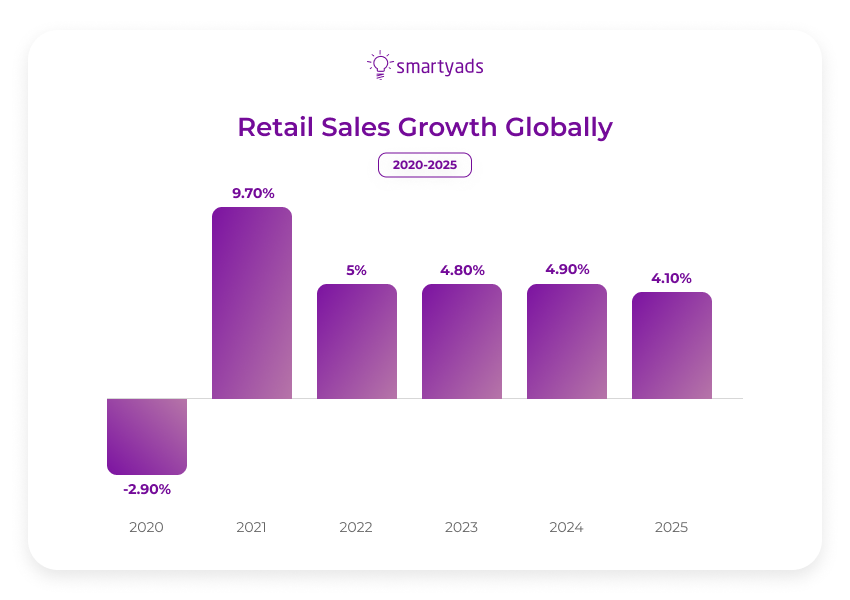
It is now anticipated that the fastest-growing categories, such as food and beverage, will rise to 58.5% of total retail sales, compared to the previously forecasted 23.4%.
At the same time, beauty sales predictions have increased from 16.6% to 32.4%, and a similar trend is observed for other categories.
The opportunity is just too huge to be missed, and the leading global ecommerce brands have already entered the race for online shoppers. What are their best Ecommerce advertising methods, and what can you adopt to maintain brand awareness and sales? We'll find out in this article!
What is Ecommerce advertising?
Ecommerce advertising refers to promoting products or services offered by an online business through various digital marketing channels to attract potential customers and drive sales.
Ecommerce ads are fueled mainly by online advertising and social media platforms.
Ecommerce advertising strategies include the application of:
- Google ads and other display ads (aka paid ads, video marketing included);
- Search engine marketing, along with search engine optimization;
- Social media ads (social media marketing platforms) and influencer marketing on social media;
- Search ads (Google search campaigns);
- Programmatic digital ads;
- Email marketing;
- Content marketing.
An effective ecommerce advertising strategy is supposed to increase brand awareness, drive website visitors to the online store, and ultimately generate conversions and sales.
Ecommerce businesses use various advertising strategies and ecommerce advertising platforms to target specific audiences based on their interests, demographics, behavior, and location.
By understanding consumer behavior and leveraging data analytics, ecommerce businesses can create personalized and targeted ad campaigns that resonate with their potential customers, leading to increased engagement, conversions, and revenue.
Now let's review those ecommerce marketing approaches one by one.
Google ads (Google display network)
Google advertising is more than just search ads that appear in the top results when you search for something. You can see the example of search ads (paid search ads) below.
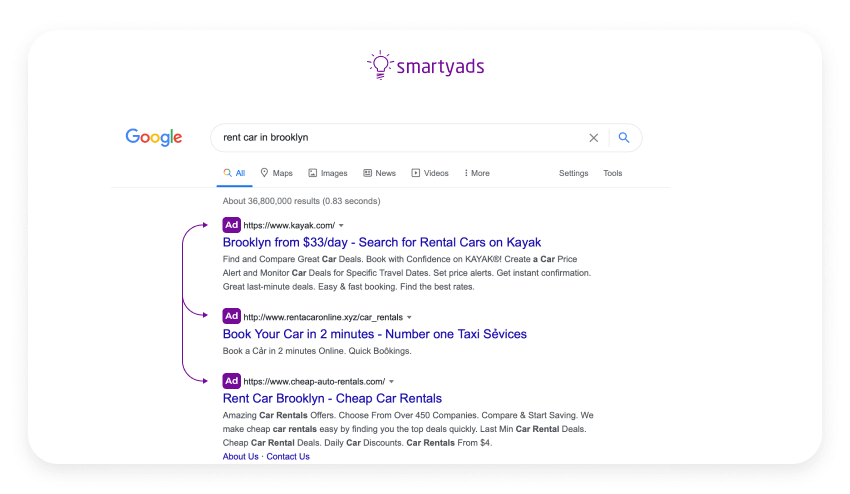
There is also a platform for advertisers, thanks to which they can launch Google shopping campaigns.
The Google Display Network (GDN) is a vast network of websites, mobile apps, and videos where advertisers can display their ads to a broad audience.
It is an advertising platform operated by Google that allows businesses to reach their customers using visual ads, such as banner ads, image ads, and video ads, across millions of websites, mobile apps, and video content.
The GDN reaches over 90% of Internet users worldwide, making it one of the world's largest advertising networks.
It uses advanced targeting and optimization features, including demographic, location, interest-based, and behavior-based targeting, to help advertisers reach their desired audience effectively.
How can Google display advertising be useful for Ecommerce businesses?
Google shopping ads are the most helpful option in display networks (for ecommerce businesses). Why? Because Google shopping ads will allow marketers to involve such data in their display advertising units: photos, price, title, and reviews.
These ads will appear in the search engines when the user looks for something thematically related (and inputs keywords specifically targeted by the advertiser). You can see an example of the shopping ads below.
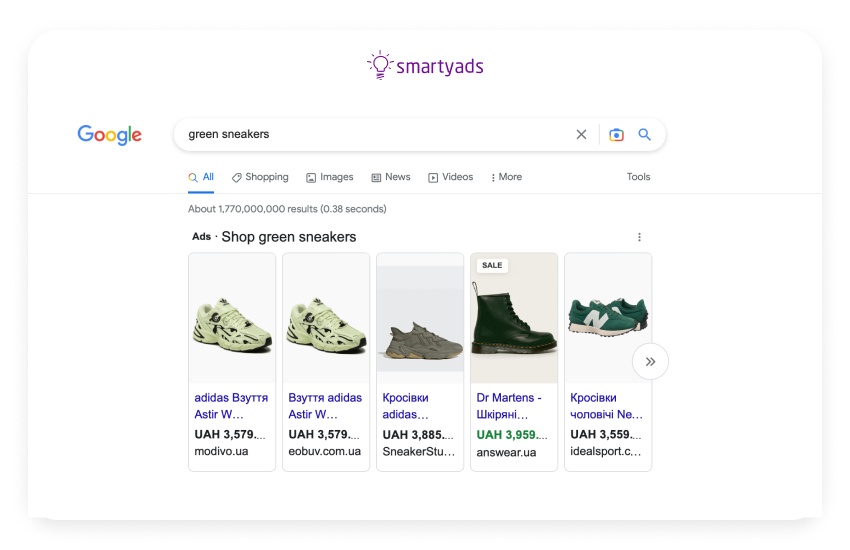
How to organize paid search advertising in Google?
Here are the general steps to set up a Google Search Ad campaign:
- Create a Google Ads Account;
- Set up a New Campaign. Then, choose "Search" in the campaign type to activate the search advertising campaign (if you want to run display ads, then choose this type);
- Define Your Campaign Settings. Set your campaign's geographic targeting, language, bidding strategy, and budget;
- Create Your Ad Groups. Create one or more ad groups within your campaign, each with its own set of keywords and ads. Each ad group should be focused on a specific theme or product;
- Choose Your Keywords. Select relevant keywords for each ad group that people might use to search for your products or services. These keywords will be inputted into search engine results;
- Create Your Ads and adjust other details like bid amounts, budget, etc.
Then your paid search campaigns can be launched, and the ad will appear in search engines each time the user searches for something related to the keywords you target.
Example of L'Oreal Google ads campaign
An excellent example is L'Oreal's Shu Uemura makeup brand which employed algorithmic capacities of Google Adwords for their ad campaign.
In 2010, the company received global recognition, but poor performance in North America required a more impactful approach to raising brand awareness.
Since they had limited distribution on the continent, the solution could only be found in programmatic advertising, as CPM campaigns are useful for raising brand awareness.
They decided to target women aged 25-30 with a history of online makeup purchasing. This audience was also divided into segments by the customer journey stages, and each segment was attributed to a unique creative.
The results were quick to come as the brand received a considerable increase in traffic and, most importantly, twice more significant revenue than initially anticipated.
Programmatic online advertising
Programmatic advertising is one of the first things that comes to mind when you think about precise targeting across multiple platforms. The technology is widely used across ecommerce advertising for almost every business vertical.
Programmatic paid ads are even more popular than Google paid advertising for several reasons. They are very similar, and at the same time, they have differences in terms of reach and environments. Read more about it in the article — Programmatic ad network or Google display network.
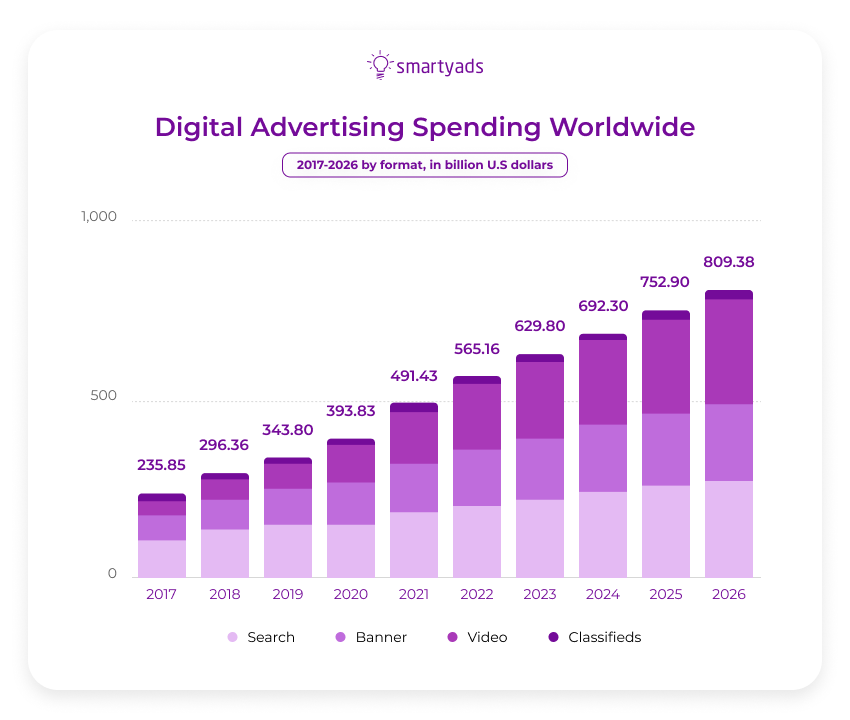
As the picture above shows, programmatic advertising spending grows exponentially and accounts for at least 70% of all digital advertising budgets worldwide.
It is very cost-effective, allowing brands to choose a bidding model (such as cost-per-mille or PPC ads) under specific business goals.
By opting for a programmatic ads strategy, brands can save lots of time and money, as they significantly simplify the process of media trading because ads are purchased per impression (based on the auction model).
How does it work in a nutshell?
Programmatic is a revolutionary paid advertising strategy because it automates the processes of buying and selling ecommerce ads.
The advertiser can serve ecommerce ads through the demand-side platform that automatically runs real-time bidding auctions and organizes direct programmatic deals.
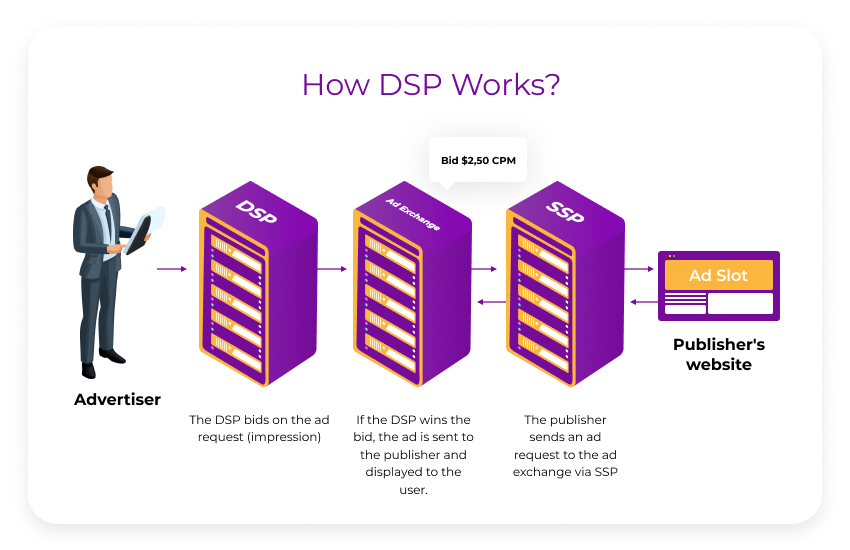
Thanks to the targeting options, it allows advertisers to utilize user data to find potential customers and channel it to the right viewer.
The optimal ecommerce marketing strategy may typically involve both Google ads and programmatic. Advertisers create ads on programmatic platforms because those can offer several undeniable unique advantages.
Advantages of programmatic advertising
Variety of ad formats. As programmatic advertising campaigns can be organized on different channels (in-app, mobile web, desktop, audio, CTV), the platforms typically offer more ad formats than Google ads or social media platforms.
Video ads, native ads, remarketing ads, and interactive ads like rewarded make only the tip of the iceberg. There is a variety of ad creatives that advertisers can apply.
Diverse ecosystem. While the inventory of Google ads is only represented by placements within Google's ecosystem, programmatic can offer more diverse access to inventory types, including rare ones like DOOH, where ad spending grows exponentially.
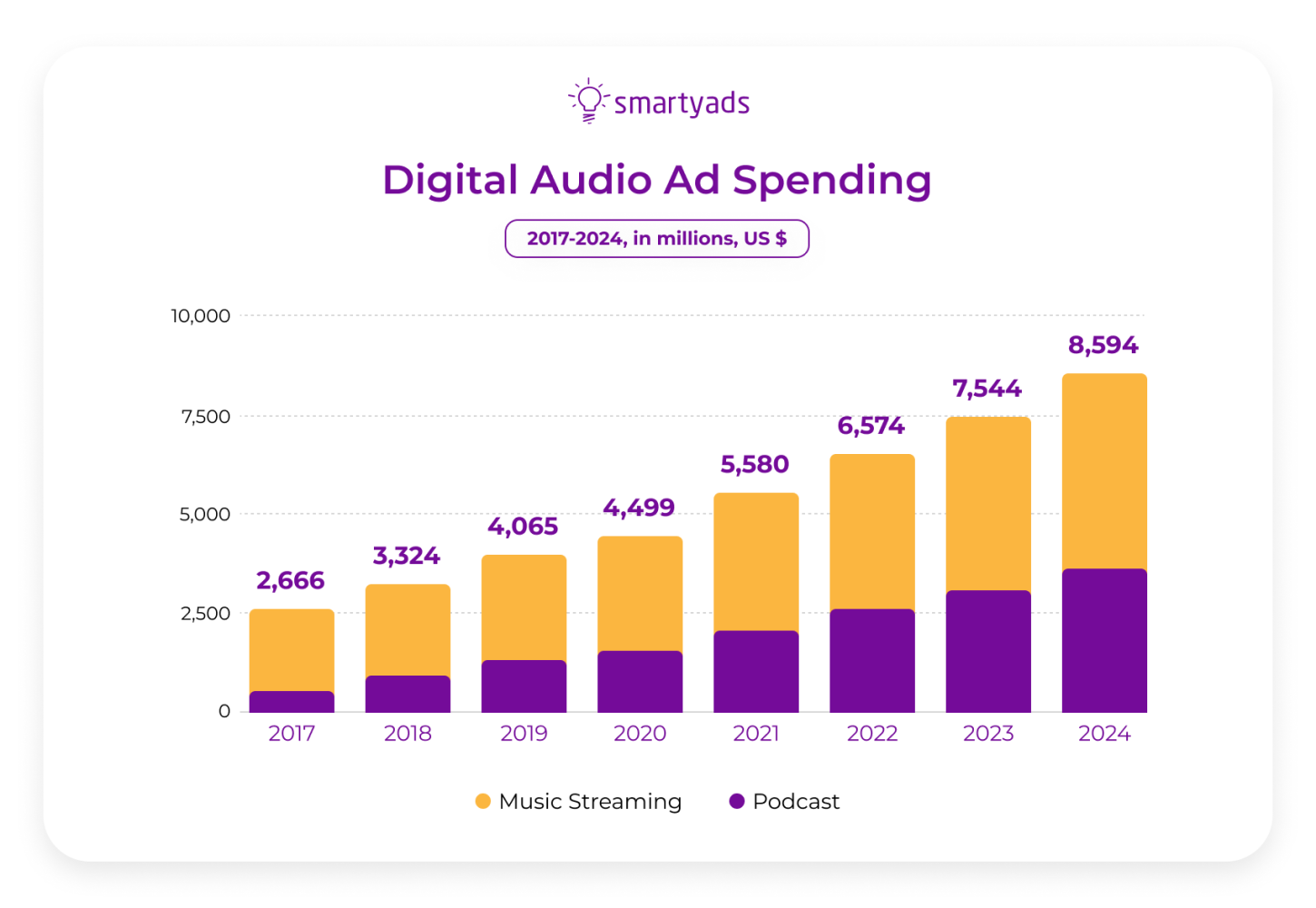
Additional benefits:
- Efficient and Cost-Effective. Programmatic advertising uses real-time bidding technology to buy and sell ad inventory, which is faster and more efficient than traditional ad-buying methods. This makes programmatic advertising more cost-effective for launching ecommerce ads;
- Better Targeting. Programmatic advertising allows brands to target their ads more accurately to their desired audience, using data on user demographics, interests, and behavior;
- Precise Measurement. Programmatic advertising allows brands to track the performance of their ads more precisely, with data on impressions, clicks, conversions, and other metrics available in real time;
- Improved Brand Safety. Programmatic advertising offers features to ensure brand safety, such as the ability to exclude specific websites or content categories from ad placements. This helps brands to avoid appearing next to inappropriate or harmful content;
- Dynamic Optimization. Programmatic advertising allows brands to optimize their campaigns in real time, with the ability to adjust bids, targeting, and creative based on performance data. This helps brands to achieve better results and maximize their ROI.
How can programmatic advertising be useful for Ecommerce businesses?
Programmatic falls within super effective ecommerce advertising techniques because it can boost Ecommerce sales through the most precise targeting. Ecommerce brands can also target customers based on location and drive them to brick-and-mortar Ecommerce stores.
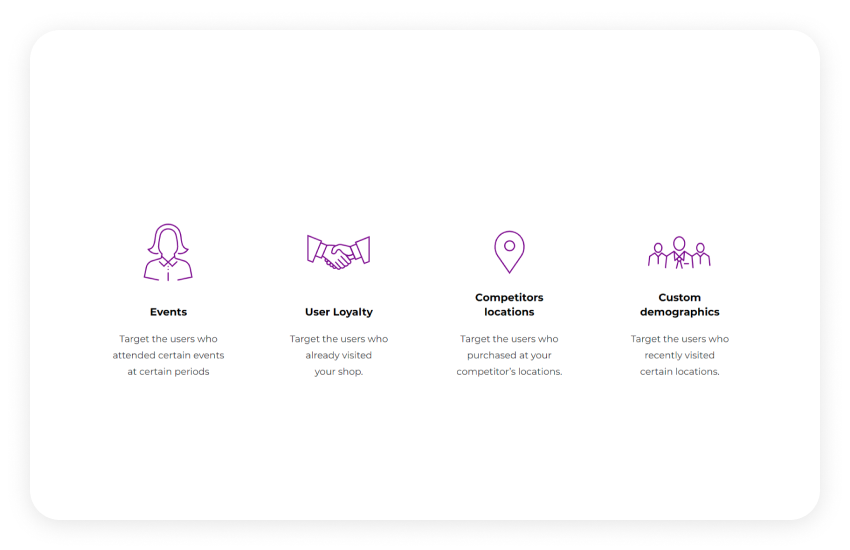
Brands can also target customers near competitor's ecommerce store with ads that offer great discounts. Read more about geofencing and geotargeting campaigns. Also, see examples of best ecommerce ads (with best practices).
How to start with programmatic campaigns?
The algorithms are pretty much the same as for Google's platform. First, the marketer must register at the demand-side platform, fill out campaign details, define the budget, and activate the campaign.
Display ads will be served as soon as the campaign is activated and the team moderates the creative. Then advertisers can make adjustments and optimizations to improve campaign performance.
Social media platforms
Social media advertising is a sure way to appeal to large audiences because social media gather all kinds of audiences. People spend most of their time on social media apps; the number of smartphone users is increasing worldwide, meaning that ecommerce companies can target users wherever they are.
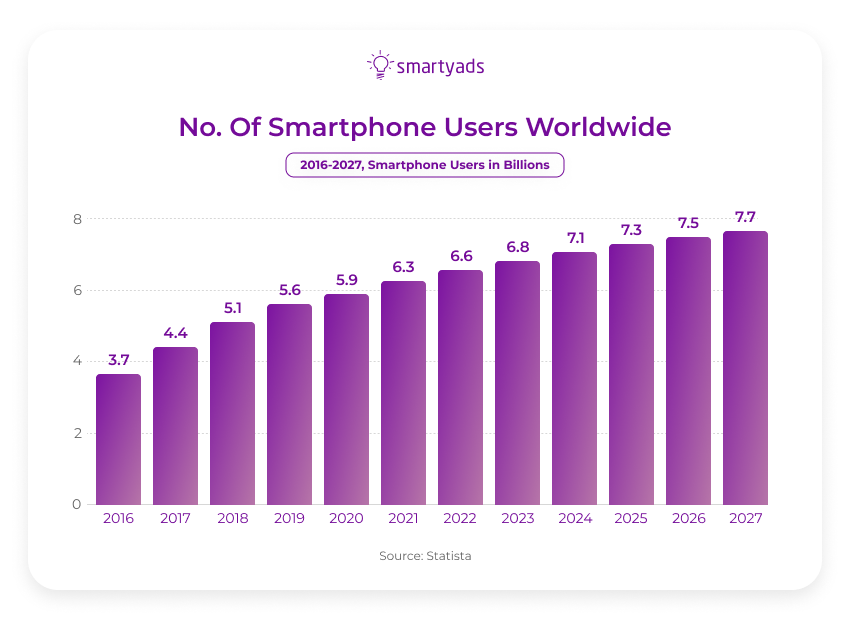
Ecommerce companies can leverage social media advertising in the following ways:
- Create targeted ecommerce ads. Ecommerce companies can create targeted ads shown to users based on their interests, demographics, and behaviors. Social media platforms such as Facebook, Instagram, and Twitter offer advanced targeting options that can help brands reach their desired audience;
- Run influencer campaigns. Ecommerce companies can collaborate with influencers who have a large base of followers on social media to promote their products;
- Use social media to showcase products. Ecommerce companies can use social media to showcase their products and build excitement around new releases. Brands can post high-quality photos and videos of their products, share content generated by users, and run contests to engage their followers;
- Utilize social commerce. Social commerce is a new trend that allows customers to purchase products directly on social media. Ecommerce companies can use social commerce to sell their products without customers having to leave the platform;
- Engage with customers. Ecommerce companies can use social media to engage with their customers by responding to comments and messages, asking for feedback, and addressing any concerns or issues that customers may have.
How can social media advertising be useful for Ecommerce companies?
Social media ads can help brands achieve higher customer acquisition and retention as it fosters loyalty to the brand. They can also effectively drive attention to product pages. On social platforms, brands can run ecommerce campaigns with unique formats.
For example, a Facebook video ad is an effective tool for brands to showcase their products and tell their brand story:
- Collection Ads. Collection ads are a type of ad format on Facebook and Instagram that allow ecommerce companies to showcase multiple products within a single ad;
- Dynamic Product Ads. Dynamic product ads allow ecommerce businesses to retarget users who have previously interacted with their products on their landing pages.
How to start with paid social media ads?
In order to start running paid social ecommerce ads, first, brands need to choose a platform for social media advertising — Instagram ads, Twitter, LinkedIn, or Facebook Ads Manager.
Then the brand should choose available ad formats. Social media platforms offer several ad units, including image ads, video ads, carousel ads, and more. Choose the format that best fits your goals and message.
After this, you can select targeting and start a campaign like on any other platform.
On social media, you can run the best ecommerce ads. However, it's worth remembering that they will appear only across a selected range of inventory (represented by social platforms). It means that users won't interact with ads in search or when browsing the articles on some websites (compared to programmatic).
Email marketing
Promoting goods and services with email marketing may seem like an old strategy, but it is still here — it is most effective for targeting existing customers and generating leads.
Email marketing is a digital marketing strategy that involves sending commercial messages, typically in the form of email newsletters, to a group of subscribers. Email marketing aims to build relationships with customers, promote brand awareness, and drive sales and revenue.
Email marketing campaigns typically involve sending targeted messages to a list of subscribers who have opted-in to receive emails from the brand. These emails can include various content, such as promotional offers, product updates, company news, and educational content.
Email marketing can also be an effective way to drive conversions and revenue for ecommerce companies. By including calls-to-action and promotional offers in their emails, brands can encourage subscribers to purchase or take another desired action.
Email ad campaigns are:
- Cost-effective. Compared to other forms of marketing, email marketing is relatively inexpensive. There are low or no costs associated with sending emails to subscribers, making it a cost-effective way to reach a large audience;
- Targeted. Email marketing allows businesses to send personalized messages to specific audience segments. By segmenting email lists based on subscriber behavior or preferences, businesses can tailor their messages and increase engagement and conversion rates;
- Great at building customer relationships. Email marketing is a great way to build relationships with customers and keep them engaged with a brand;
- Great at driving sales and revenue. Email marketing can effectively drive sales and revenue for businesses, particularly for ecommerce companies.
How can email marketing be useful for Ecommerce companies?
One of the key benefits of email marketing is that it allows brands to target specific audience segments with personalized messages. For example, brands can send different emails to customers who have made a purchase or those who have not yet made a purchase in the online store, or customers who have shown interest in specific products or services.
How to start with email marking?
Before launching an email ad campaign, building a quality email list of subscribers who have opted-in to receive emails from your brand is essential. You can do this by offering incentives to customers who sign up for your email list, such as exclusive discounts or free content. Personalizing the campaigns for each segment will significantly improve the campaign's performance.
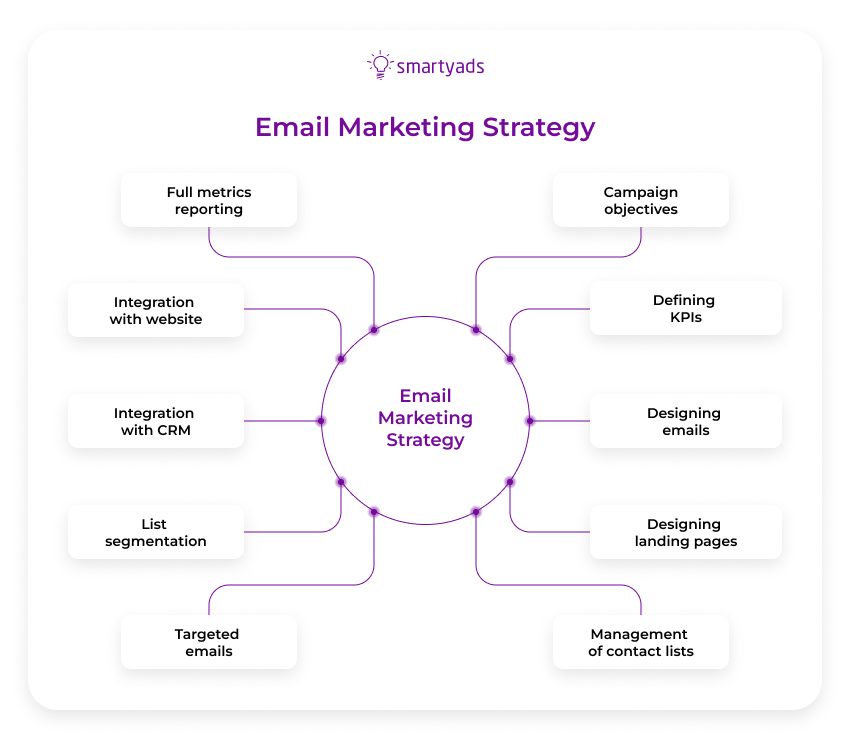
Content marketing
Ecommerce sites can also greatly benefit from written content: educational materials for customers, SEO-optimized articles with market insights, and so on.
The content can take many forms, including blog posts, articles, videos, social media posts, useful landing pages, infographics, white papers, case studies, e-books, and more. The key is that the content must provide value to the audience and address their needs, interests, or pain points.
It is a long-term strategy focusing on building relationships with the audience rather than directly promoting products or services.
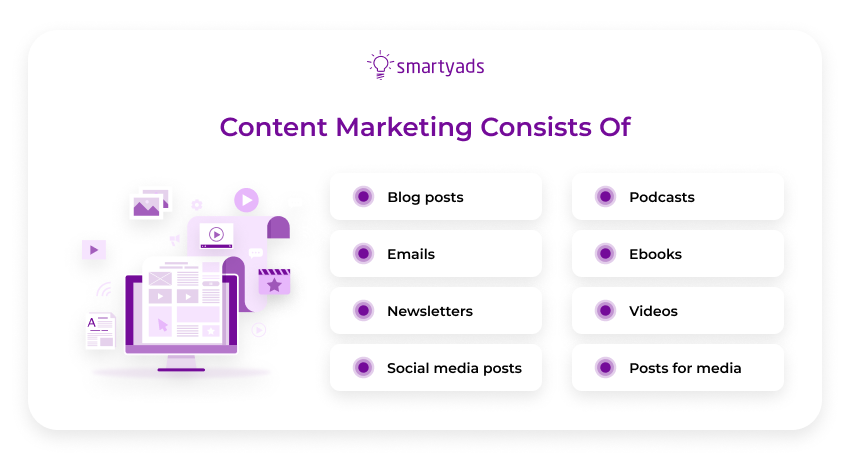
By providing helpful and informative content, businesses can establish themselves as thought leaders in their industry and gain the trust and loyalty of their target audience. This, in turn, can lead to increased brand awareness, website traffic, lead generation, and, ultimately, sales.
Advantages of content marketing:
- Builds brand awareness. Creating valuable content helps to build brand awareness and increase your online presence;
- Cost-effective. Compared to other forms of marketing, it is very affordable;
- Increases customer loyalty. By providing ongoing value to your audience, you can increase customer loyalty and encourage returning to the brand;
- Improves search engine rankings. Search engines like Google reward websites that publish high-quality, relevant content with higher search engine rankings.
How can content efforts be useful for Ecommerce companies?
In the competitive world of ecommerce, creating high-quality content is essential. This means creating content that is visually appealing, informative, and engaging. Consider using a mix of formats, such as blog posts, videos, infographics, and social media posts, to keep your content fresh and engaging.
Creating great content is only half the battle. To maximize its impact, you need to promote it across multiple channels, such as social media or email.
Building an impeccable image also constitutes writing press releases and big media articles.
How to start with content strategy?
Content creation is a much longer process compared to paid media ad placement. In order to start off, an ecommerce company needs to compose a content strategy, determine KPIs that need to be achieved, hire content specialists, or commission content creation to third-party services.
Leveraging Ecommerce platforms
Those platforms are software applications that allow businesses to create online stores and sell their products or services online. These platforms provide a range of tools and features to help businesses manage their online stores, including product catalog management, payment processing, order fulfillment, shipping, and customer management.
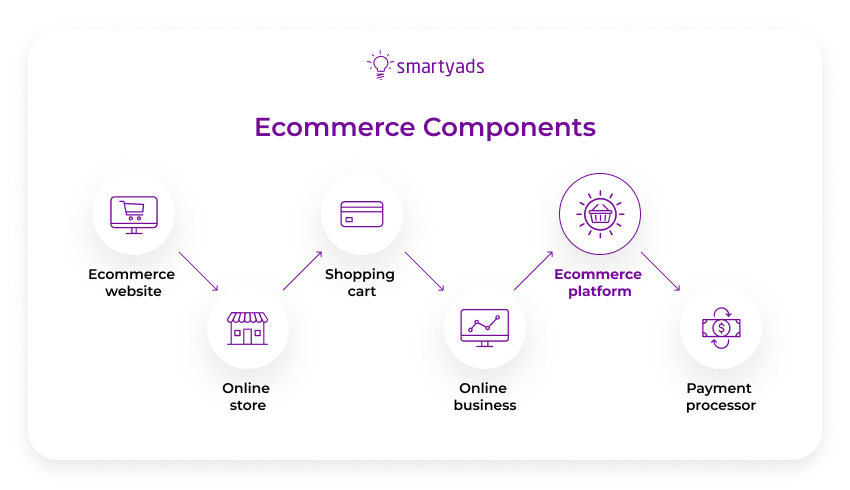
There are two main types of these platforms:
- Hosted platforms. Hosted platforms are cloud-based software applications that are managed by a third-party provider. Businesses can create an online store on these platforms by signing up for a subscription and customizing a pre-built website template. Hosted platforms typically offer a range of features and integrations to help businesses manage their online stores;
- Self-hosted platforms. Self-hosted platforms are open-source software applications that businesses can download and install on their own servers. These platforms provide more flexibility and control over the ecommerce store's design and functionality but require more technical expertise to set up and maintain.
Some popular platforms include Shopify, WooCommerce, Magento, BigCommerce, and Squarespace. The choice of platform depends on the business's needs, budget, and technical expertise.
Tips on how to leverage platforms for Ecommerce to grow your business:
- Optimize your product listings. Optimizing your product listings is important to attract more customers and improve conversions. Ensure you include high-quality product images, detailed descriptions, and pricing information. You can also use customer reviews and ratings to build trust and increase social proof;
- Use data to drive decision-making. Ecommerce platforms provide valuable data on customer behavior, sales trends, and website performance. Use this data to make informed decisions about product development, pricing, marketing, and website optimization;
- Offer personalized experiences. Collect data on your customers' behavior, preferences, and purchase history. Use this information to offer personalized experiences, such as personalized product recommendations, targeted promotions, and customized content;
- Optimize for mobile. More and more customers do the shopping on mobile devices, so optimizing your ecommerce platform for mobile is important. Make sure your website is mobile-responsive and offers a seamless user experience across all devices;
- Integrate with other tools and platforms. Those platforms offer a range of integrations with other tools and platforms, such as email marketing, social media, and accounting software. Take advantage of these integrations to streamline your workflows, improve efficiency, and drive more sales;
- Provide excellent customer support. Platforms for ecommerce provide a range of tools to manage customer inquiries and support. Ensure you provide excellent customer support through multiple channels, such as email, chat, and phone, to build customer loyalty.
More aspects that impact the success of your Ecommerce ads and business promotion
Well-researched niche audience
A well-defined niche audience is a fundamental value for any ad campaign. One ecommerce business obviously cannot satisfy everyone's needs, so a crucial step for successful advertising and marketing in ecommerce is to define and target the audience interested in the specific product or service your business delivers.
Define your market and your target audience persona, then tailor a particular message to them so that it perfectly resonates with a search term they use most frequently. The best thing you can do for your customers when building your online advertising strategy is to speak their language.
Thus, make sure to display ads that show that you care. Here are two examples to illustrate how such an ecommerce advertising strategy should work:
Nine Line is an excellent example of a brand with precisely defined target audiences and a specific message that fits them.
Veterans founded the company; they hired veterans, addressed veterans, and appealed to their needs and values in the ads.
Using specific language, Google search keywords, and designs strengthen their message and increase customer loyalty. Such a strategy creates a clear brand image that makes it unique and recognizable.
Not sure who your target audience is and what they are looking for? A common element of online advertising mechanisms in ecommerce is a survey.
You can use reviews to communicate with your customers on the different stages of the buyer's journey in the same way that Society Socks does. They created a series of relevant, user-friendly surveys and asked their visitors for feedback.
They simplified the process and reached their prospects at the right time via the right channel. This way, the company increased response rates by 200% and gathered valuable user data.
A clear message that underlines your brand's strengths
Defining your audience is just a foundation crucial for achieving the next step — tailoring a clear and understandable message highlighting your product's unique strengths. This stage is vital for online marketing and advertising in ecommerce.
You can get lots of high-quality traffic, but turning this traffic into conversions makes communication your number one goal.
Remember that the message on your banner ads should be clear and engaging, and your landing page should accurately describe your products and their strengths. If you offer something valuable — let your customers know. Here are some examples:
Budapester, a German fashion retailer, had a low conversion rate despite lots of traffic. Their mobile version of the website performed even worse, so to improve the situation, the first thing they did was website optimization.
They decreased their logo size and ensured the users got all the information conveniently. Specifically, shipping options, product availability, and free delivery offers could be found right on the product web page.
The result? 12.5% increase in conversion rate for desktop and up to 30% for mobile. These are pretty significant changes for minor website optimization, but that is how effective communication works.
We can find another example of effective online marketing communication in the case of a small paper company, Paperstone, which competed with larger brands.
To stay ahead in the challenging market, they chose one of the best strategies — to demonstrate their advantages compared to other companies.
Price was defined as one of the core advantages, so the solution was simple — adding a price comparison table throughout their website so the customer could instantly decide without checking the competitors' offers and online ads.
As a result, their online sales increased by almost 11%. This campaign practically refers to a successful ecommerce advertising definition.
User-generated content & word-of-mouth
There's probably no better match for ecommerce and advertising than testimonials of your happy customers. People trust their friends' recommendations rather than ads or blog posts.
The good thing about it is that your satisfied customers can often help you with more than a dozen online marketing tools.
They can spread the word about you, help you reach new customers, and even showcase their use of your products. The benefits of such promotion are hard to overestimate, as we will see from the following example:
'Diamond Candles' is a beautiful example of a successful digital marketing strategy based on this method.
This ecommerce advertising strategy increased their conversion rates by 13%, boosting brand awareness and customer loyalty. To achieve that, they offered a ring inside every marked candle and encouraged their clients to share photos of the ring on social media.
Then, they collected galleries to create more substantial brand recognition to get even more exposure via Facebook ads. This way, they transformed buying a candle into an adventure and their customers into their brand ambassadors.

Omnichannel marketing
So we know how to get a decent brand reputation and sales. The core element is to create a personalized experience for your precisely defined target audience. But how to make your business' performance not just decent but outstanding?
What kind of strategy should a brand choose in this case? Meet omnichannel marketing! Here is an example of how a leading fashion brand used it.
Seamless, personalized user experience across all platforms and stores is a mission chosen by Zara's ecommerce advertising team.
To achieve this, they've created an easy-to-navigate website that vividly showcases their products and provides all the information for the purchase. They also created a mobile app with the same notion of user experience.
Finally, they've also crafted personalized email notifications for their clients. The key feature of these emails was relevance, so they kept messages precisely targeted to each audience segment, e.g., clients who have kids received updates about new items in the category for children.

Conclusions
Leveraging the best practices of ecommerce and advertising, you can impact your business success and obtain significant long-term benefits such as user loyalty.
Start researching your audience, then create precise messaging for each segment of your audience. Finally, apply programmatic advertising solutions to personalize message delivery for every customer. As a result, your ecommerce advertising will always be engaging and cost-effective.
